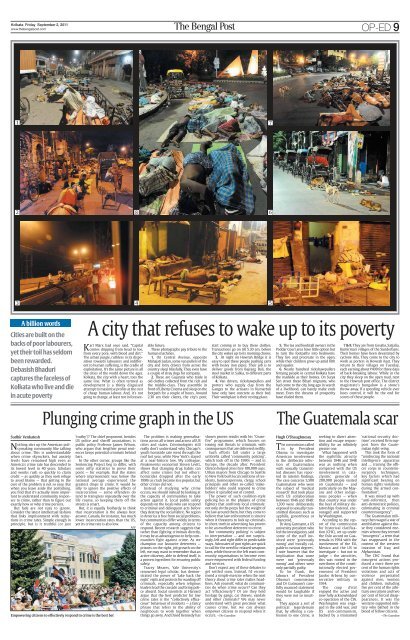02 page1 city layout 1
02 page1 city layout 1
02 page1 city layout 1
Create successful ePaper yourself
Turn your PDF publications into a flip-book with our unique Google optimized e-Paper software.
Kolkata Friday September 2, 2011<br />
www.thebengalpost.com OP-ED 9<br />
1<br />
2<br />
A billion words<br />
Cities are built on the<br />
backs of poor labourers,<br />
yet their toil has seldom<br />
been rewarded.<br />
Debasish Bhaduri<br />
captures the faceless of<br />
Kolkata who live and die<br />
in acute poverty<br />
Sudhir Venkatesh<br />
Nothing stirs up the American policymaking<br />
community like talking<br />
about crime. This is understandable<br />
when crime skyrockets, but anxiety<br />
levels have remained high even as<br />
America’s crime rate has descended to<br />
its lowest level in 40 years. Scholars<br />
and wonks rush so quickly to claim<br />
credit — as quickly as they seek refuge<br />
to avoid blame — that getting to the<br />
core of the problem is not so easy. But<br />
when you leave aside the politicking,<br />
you find that it’s actually more important<br />
to understand community respon -<br />
ses to crime, rather than to figure out<br />
exactly how or why crime persists.<br />
But fads are not easy to ignore.<br />
Consider the latest intellectual fashion<br />
that links imprisonment with reductions<br />
in crime rates. Simple enough in<br />
principle, but is it truthful (or just<br />
A <strong>city</strong> that refuses to wake up to its poverty<br />
Karl Marx had once said, “Capital<br />
comes dripping from head to toe,<br />
from every pore, with blood and dirt.”<br />
The urban jungle, ruthless in its disposition<br />
towards labourers and indifferent<br />
to human suffering, is the cradle of<br />
exploitation. It’s the same picture in all<br />
the cities of the world down the ages.<br />
Kolkata, the <strong>city</strong> with a heart, toes the<br />
same line. What is often termed as<br />
development is a thinly disguised<br />
attempt to maximise profits at the cost<br />
of cheap human labour. And, it’s not<br />
going to change, at least not in foresee-<br />
able future.<br />
These photographs pay tribute to the<br />
human machines.<br />
1. On Central Avenue, opposite<br />
Mahajati Sadan, some van pullers of the<br />
<strong>city</strong> and lorry drivers from across the<br />
country sleep blissfully. They even have<br />
a couple of stray dogs for company.<br />
2. These are Gujaratis who trade in<br />
old clothes collected from the rich and<br />
the middle-class. They assemble in<br />
front of Liberty Cinema and sleep on the<br />
footpath for a couple of hours. Around<br />
2.30 am their clients, the <strong>city</strong>’s poor,<br />
Plunging crime graph in the US<br />
‘truthy’)? The chief proponent, besides<br />
US police and sheriff associations, is<br />
public policy Professor James Wilson,<br />
who argues that lengthier penal sent -<br />
en ces keeps potential criminals beh ind<br />
bars.<br />
In the other corner, groups like the<br />
Sentencing Project beg to differ, with<br />
some nifty statistics to prove their<br />
point — for example, that the states<br />
where imprisonment was below the<br />
national average experienced the<br />
greatest drops in crime. It would be<br />
silly to ignore the positive effects of<br />
incarceration — some offenders do<br />
tend to transgress repeatedly over the<br />
life course, so keeping them off the<br />
streets is smart.<br />
But, it is equally foolhardy to think<br />
that incarceration is the always best<br />
answer. Canada, for instan ce, has much<br />
lower incarceration rates than the US,<br />
yet its crime rate is also low.<br />
AFP<br />
Empowering citizens to effectively respond to crime is the best bet<br />
8<br />
3 4 5<br />
The problem is making generalisations<br />
across all crimes and across all US<br />
cities and states. Criminologists still<br />
really don’t understand why Chicago’s<br />
youth homicide rate went through the<br />
roof last year, while New York’s stayed<br />
at a near-historic low. My colleague,<br />
Freakonomics economist Steven Levitt,<br />
shows that changing drug habits can<br />
affect some crimes but not others:<br />
homicides dropped after the early<br />
1990s as crack became less popular, but<br />
other crimes did not.<br />
Instead of studying why crime<br />
occurs, we should instead be looking at<br />
the capa<strong>city</strong> of communities to take<br />
action against it. Local public safety<br />
depends on the locals who can respond<br />
to criminal and delinquent acts before<br />
they destroy the social fabric. No region<br />
in America is free from social problems,<br />
but communities differ widely in terms<br />
of the capa<strong>city</strong> among citizens to<br />
respond. Recent research suggests that<br />
rather than fighting criminals directly,<br />
it may be as advantageous to help communities<br />
fight against crime. As we<br />
champion our favourite deterrents —<br />
prisons on the right, job growth on the<br />
left, we may want to remember that an<br />
active citizenry, able to defend itself, is<br />
a proven ingredient for ensuring public<br />
safety.<br />
Tracey Meares, Yale University's<br />
renowned legal scholar, has demonstrated<br />
the power of ‘take back the<br />
night’ vigils and protests for warding off<br />
criminals, especially when religious<br />
leaders lead the crusade and bring poli -<br />
ce aboard. Social scientists at Harvard<br />
argue that the best predictor for low<br />
crime rates is the “collectively efficacious”<br />
behaviour of residents — a fancy<br />
phrase that refers to the ability of<br />
neighbours to work together when<br />
things go awry. And David Kennedy has<br />
start coming in to buy these clothes.<br />
Transactions go on till 5.30 am. before<br />
the <strong>city</strong> wakes up to its morning chores.<br />
3. At night on Howrah Bridge it is<br />
easy to spot these people pushing carts<br />
with heavy iron pipes. Their job is to<br />
deliver goods from Bajrang Bali, the<br />
steel market in Salkia, to different parts<br />
of Kolkata.<br />
4. Van drivers, rickshawpullers and<br />
porters who supply clay from the<br />
Ganges to the artisans in Kumartuli<br />
have only bare concrete as their bed.<br />
Their workplace is their resting place.<br />
shown proven results with his “Cease -<br />
fire” programme, which focuses on<br />
issuing real threats to criminals, with<br />
consequences that are delivered swift ly.<br />
Such efforts fall under a large<br />
umbrella called ‘community policing’,<br />
which took off in the 1990s — and in<br />
Europe, the decade after. President<br />
Clinton helped cities hire 100,000 cops.<br />
Urban mayors from Chicago to Seattle<br />
to New York built local coalitions of residents,<br />
businesspersons, clergy, school<br />
principals and other so-called ‘stakeholders’<br />
who could respond to crime<br />
before it spiralled out of control.<br />
The power of such coalition-style<br />
policing lies in the phalanx of crime<br />
fighters that confronts local criminals:<br />
not only do the perps feel the weight of<br />
the law around them, but they come to<br />
believe that law enforcement is sincere<br />
when it threatens to lock up criminals.<br />
In short, truth in advertising has proven<br />
to be an excellent deterrent to crime.<br />
But ‘community policing’ is subject<br />
to interpretation — and not surprisingly,<br />
left and right differ in predictable<br />
ways. Advocates of gun rights are quick<br />
to call for the need for relaxed weapons<br />
laws, while those on the left want community<br />
organisations to become even<br />
more empowered with federal funding<br />
and services.<br />
Don't expect any of these debates to<br />
get settled soon. Instead, I’d recommend<br />
a simple exercise when the next<br />
theory about crime rates makes headlines.<br />
Ask yourself, what do communities<br />
do when crime occurs? Can they<br />
act ‘efficaciously’? Or are they held<br />
host age by gangs, car thieves, vandals<br />
and other criminals? We may never<br />
understand with great precision what<br />
causes crime, but we can always<br />
empower citizens to respond when it<br />
occurs. —The Guardian<br />
7<br />
6<br />
5. The tea and foodstall owners in the<br />
Poddar Court area have little option but<br />
to turn the footpaths into bedrooms.<br />
They live and procreate in the open,<br />
while their children grow up amid filth<br />
and squalor.<br />
6. Nearly hundred rickshawpullers<br />
ferrying people in central Kolkata have<br />
the roadside as their homes. On Surya<br />
Sen street these Bihari migrants, who<br />
had come to the <strong>city</strong> long ago in search<br />
of a livelihood, can barely make ends<br />
meet. Even the dreams of prosperity<br />
have eluded them.<br />
7 & 8. They are from Gosaba, Satjalia,<br />
Kumirmari villages of the Sunderbans.<br />
Their homes have been devastated by<br />
cyclone Aila. They come to the <strong>city</strong> to<br />
work as porters in Howrah haat. They<br />
return to their villages on Tuesday,<br />
each earning about `400 for three days<br />
of back-breaking labour. While in the<br />
<strong>city</strong> they sleep on the open road, next<br />
to the Howrah post office. The district<br />
magistrate’s bungalow is a stone’s<br />
throw away. If a speeding vehicle ever<br />
loses control, it will be the end for<br />
scores of these people.<br />
The Guatemala scar<br />
Hugh O’Shaughnessy<br />
The commission call ed<br />
in by President<br />
Obama to investigate<br />
American involvement<br />
in the deliberate infection<br />
of Guatemalans<br />
with sexually transmitted<br />
diseases has repor -<br />
ted its interim findings.<br />
The case concerns 5,500<br />
Guatemalans who were<br />
the subject of ‘medical<br />
research’ that took place<br />
with US collaboration<br />
between 1946 and 1948:<br />
1,300 were deliberately<br />
exposed to sexually tran -<br />
s mitted diseases such as<br />
syphilis, gonorrhoea or<br />
chancroid.<br />
Dr Amy Gutmann, a US<br />
university president who<br />
led the investigation, said<br />
some of the staff inv -<br />
olved were ‘grie vously<br />
wrong’ and ‘mor ally culpable<br />
to various degrees’.<br />
I note however that the<br />
implication that some<br />
were not ‘grievously<br />
wrong’ and others were<br />
only partially guil ty.<br />
To be frank, the<br />
labours of President<br />
Obama’s commission<br />
and Dr Gutmann’s carefully<br />
nuanced statement<br />
would be laughable if<br />
they were not so insulting.<br />
They appear a sort of<br />
political legerdemain<br />
that, by offering a confession<br />
to one crime, is<br />
seeking to divert attention<br />
and escape responsibility<br />
for an infinitely<br />
greater one.<br />
What happened with<br />
the syphilitic atro<strong>city</strong><br />
between 1946 and 1948<br />
was as nothing when<br />
compared with the US<br />
involvement in cataclysmic<br />
genocide of<br />
200,000 people visited<br />
on Guatemala — and<br />
particularly on the May -<br />
ans and other indigenous<br />
peoples — when<br />
that country was under<br />
the heel of military dictatorships<br />
fostered, enc -<br />
ouraged and supported<br />
by Washington.<br />
According to the rep -<br />
ort of the commission<br />
for historical clarification<br />
(CHC), set up under<br />
the Oslo accord on Gua -<br />
temala in 1994 with the<br />
involvement of the EU,<br />
Mexico and the US to<br />
investigate — but not to<br />
judge — the atrocities,<br />
this was rooted in the<br />
overthrow of the constitutionally<br />
elected government<br />
of President<br />
Jacobo Arbenz by conservative<br />
military in<br />
1954.<br />
The coup d’etat<br />
enjoyed the active and<br />
now fully acknowledged<br />
co-operation of the CIA.<br />
Washington was enga -<br />
ged in the cold war, and<br />
US anti-communism,<br />
backed by a misnamed<br />
‘national security doctrine’,<br />
received firm support<br />
from the Guate -<br />
malan right-wing.<br />
This took the form of<br />
“reinforcing the national<br />
intelligence apparatus<br />
and … training the officer<br />
corps in counterinsurgency<br />
techniques,<br />
key factors which had<br />
significant bearing on<br />
human rights violations<br />
during the armed confrontation”.<br />
It was mixed up with<br />
“anti-reformist, then<br />
anti-democratic policies,<br />
culminating in criminal<br />
counterinsurgency”.<br />
The Guatemalan military<br />
then waged a war of<br />
annihilation against tho -<br />
se they considered enemies<br />
whom they termed<br />
“insurgents”, a term that<br />
has reappeared in the<br />
context of the western<br />
invasion of Iraq and<br />
Afghanistan.<br />
The CHC found that<br />
insurgent actions produced<br />
a mere three per<br />
cent of the human rights<br />
violations and acts of<br />
violence perpetrated<br />
against men, women<br />
and children, including<br />
five per cent of the arbitrary<br />
executions and two<br />
per cent of forced disappearances.<br />
It was the<br />
western-supported military<br />
who bathed in the<br />
blood of fellow citizens.<br />
—The Guardian












